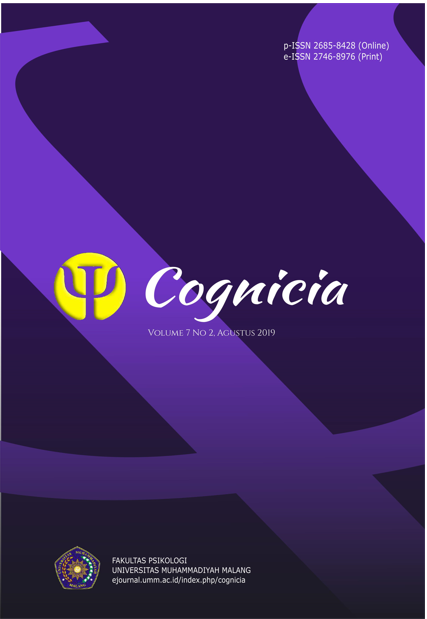Hubungan regulasi emosi dengan perilaku kekerasan dalam berpacaran pada mahasiswa
DOI:
https://doi.org/10.22219/cognicia.v7i2.9211Keywords:
Dating Violence, Emotional Regulation, StudentsAbstract
Ideally dating is sharing mutual love, attention, gentle treatment, intimacy, and romance. However, it is not uncommon to find abusive treatment from their loved ones. Emotional regulation with a poor ability to regulate emotions is associated with emotional arousal which leads to an increase in aggression behavior. The purpose of this study was to determine the relationship of emotional regulation with violent dating behavior in students. This study uses a correlational quantitative research method using a purposive sampling technique. The study was conducted on perpetrators of violence in dating with a total of 183 subjects with an age range of 18-24 years. Data collection uses the scale of DERS adaptation and scale of Violence in Dating. Data analysis method uses Pearson product moment analysis. The results showed a significant correlation between emotional regulation of dating violence (r= 0.360; r² = 0.130; p = 0,000; p <0.05).
Downloads
References
Baird, K. (2015). Understanding the role of emotion regulation in dating violence during adolescence (Vol. 119).
BBC. (2018, April). Lelaki korban kekerasan dalam pacaran: “Berjarak 10 hari dari kematian.” BBC.
Cooper, M. L. (2002). Alcohol use and risky sexual behavior among college students and youth : Evaluating the evidence*. Journaal of Studies On Alcohol/ Supplement, (14), 101–117.
Gratz, K. L., & Roemer, L. (2004). Multidimensional Assessment of Emotion Regulation and Dysregulation: Development, Factor Structure, and Initial Validation of the Difficulties in Emotion Regulation Scale. Journal of Psychopathology and Behavioral Assessment, 26(1), 41-54. https://doi.org/10.1023/B:JOBA.0000007455.08539.94
Gross, J. J. (2014). Conceptual and empirical foundations. In J. J. Gross (Ed.), Emotion Regulation (Second Edi, pp. 3–20). Guilford.
Komnas Perempuan. (2017). Kekerasan Dalam Pacaran. Komnas Perempuan.
Kuniawan, D. (2018, March). Sudah dianiaya, mahasiswa Surabaya diperkosa pacar 2 kali. Liputan 6, 2.
Lewis, S. F., & Fremouw, W. (2001). Dating Violence (A critical review of the literature). Clinical Psychology Riview, 21(1), 105–127.
Littaurer, F. (2006). Personality Plus. Jakarta: PT. Rosdakarya.
Luthra, R., & Gidycz, C. A. (2006). Dating violence among college men and women: Evaluation of a theoretical model. Journal of Interpersonal Violence, 21(6), 717–731. https://doi.org/10.1177/0886260506287312
Mason, B., & Smithey, M. (2012). The Effects of Academic and Interpersonal Stress on Dating Violence Among College Students : A Test of Classical Strain Theory. https://doi.org/10.1177/0886260511423257
NET, I. M. S. (2017). Love line Kekerasan dalam berpacaaran.
Priyono. (2016). Metode Penelitian Kuantitatif. In T. Chandra (Ed.), (edisi 2016, Vol. 91). Sidoarjo: Zifatama Publishing.
Roberton, T., Daffern, M., & Bucks, R. S. (2012). Emotion regulation and aggression. Aggression and Violent Behavior, 17(1), 72–82. https://doi.org/10.1016/j.avb.2011.09.006
Safitri, W. A. (2013). Dampak Kekerasan Dalam Berpacaran ( The Impact Of Violence In Dating ). Artikel Ilmiah Hasil Penelitian Mahasiswa UNEJ, 1(1), 1–6.
Schumacher, J. A., Feldbau-Kohn, S., Smith Slep, A. M., & Heyman, R. E. (2001). Risk factors for male-to-female partner physical abuse. In Aggression and Violent Behavior (Vol. 6). https://doi.org/10.1016/S1359-1789(00)00027-6
Shorey, R. C., Brasfield, H., Febres, J., & Stuart, G. L. (2011). An examination of the association between difficulties with emotion regulation and dating violence perpetration. Journal of Aggression, Maltreatment & Trauma, 20(January), 870–885. https://doi.org/10.1080/10926771.2011.629342
Shorey, R. C., Cornelius, T. L., & Bell, K. M. (2008). Behavioral theory and dating violence: A framework for prevention programming. The Journal of Behavior Analysis of Offender and Victim Treatment and Prevention, 1(4), 1–13. https://doi.org/10.1037/h0100452
Shorey, R. C., McNulty, J. K., Moore, T. M., & Stuart, G. L. (2015). Emotion Regulation Moderates the Association Between Proximal Negative Affect and Intimate Partner Violence Perpetration. Prevention Science, 16(6), 873–880. https://doi.org/10.1007/s11121-015-0568-5
Shorey, R. C., Zucosky, H., Bras, H., Febres, J., Cornelius, T. L., Sage, C., & Stuart, G. L. (2012). Aggression and violent behavior dating violence prevention programming : Directions for future interventions. Aggression and Violent Behavior, 17, 289–296. https://doi.org/10.1016/j.avb.2012.03.001
Sugiyono. (2018). Metode Penelitian Kuantitatif, Kualitatif, dan R&D (27th ed.). Bandung: ALFABETA CV.
Tarso. (2017). Baru pacaran saja, cewek alumni poltek ini mengalami kekerasan fisik dari cowoknya, ini pengakuannya. SRIPOKU.Com.
Wolitzky-taylor, K. B., & Ruggiero, K. J. (2008). Prevalence and correlates of dating violence in a national sample of adolescents. J. Am Acad. Child Adolesc, Psychiatry, 47(7), 755–762. https://doi.org/10.1097/CHI.0b013e318172ef5f
Downloads
Published
How to Cite
Issue
Section
License
Copyright (c) 2019 Puspita Megawati, Zainul Anwar, Alifah Nabilah Masturah

This work is licensed under a Creative Commons Attribution-ShareAlike 4.0 International License.
Authors who publish with Jurnal Cognicia agree to the following terms:
- For all articles published in Jurnal Cognicia, copyright is retained by the authors. Authors give permission to the publisher to announce the work with conditions. When the manuscript is accepted for publication, the authors agree to automatic transfer of the publishing right to the publisher.
- Authors retain copyright and grant the journal right of first publication with the work simultaneously licensed under a Creative Commons Attribution-ShareAlike 4.0 International License that allows others to share the work with an acknowledgment of the work's authorship and initial publication in this journal.
- Authors are able to enter into separate, additional contractual arrangements for the non-exclusive distribution of the journal's published version of the work (e.g., post it to an institutional repository or publish it in a book), with an acknowledgment of its initial publication in this journal.
- Authors are permitted and encouraged to post their work online (e.g., in institutional repositories or on their website) prior to and during the submission process, as it can lead to productive exchanges, as well as earlier and greater citation of published wor (See The Effect of Open Access).

This work is licensed under a Creative Commons Attribution-ShareAlike 4.0 International License







